April 18, 2017
By Mark Terry, BioSpace.com Breaking News Staff
In 2016, Pfizer brought in $52.8 billion. Keith Speights, writing for The Motley Fool, looks at how the company makes its money.
Pfizer had been discussing breaking itself into two separate companies for a couple years, with the intention of one being focused on older, mature drugs and the other on research-and-development and new-market, fast-growing drugs. Eventually the decision was made last year to stay whole. As such, Pfizer has two business units—innovative health and essential health. Basically, innovative health is the fast-growing money maker, while essential health is the more staid, steady division, although really not by that much.
The innovative health division brought in $29.2 billion last year. The essential health segment reported $23.6 billion.
Speights writes, “What might be surprising, though, is that the essential health segment actually claims a higher profit margin than innovative health does. Last year, essential health produced income from continuing operations before taxes of $12.9 billion—a profit margin of 54.6 percent. Innovative health generated income from continuing operations before taxes of $15.9 billion, which reflects a slightly lower profit margin of 54.3 percent.”
Innovative health has six categories: internal medicine, vaccines, oncology, inflammation & immunology (I&I), rare disease, and consumer healthcare. Internal meds drugs bring in the highest revenue, almost $8.9 billion last year. Vaccines ranked next, with more than $6 billion in sales. Oncology drugs brought in about $4.6 billion, and I&I about $3.9 billion. They were followed by consumer healthcare ($3.4 billion) and rare diseases ($2.4 billion).
Internal medicine has three of Pfizer’s nine blockbuster drugs, as well as two of its fastest growing—Chantix for smoking cessation and Eliquis, a blood thinner. But its cancer drugs, Ibrance and Xtandi, as well as arthritis treatment Xeljanz, are faster growers.
Its top internal med drug is Lyrica, with $4.2 billion for that drug alone last year. Lyrica is used to treat epilepsy, post-herpetic neuralgia and diabetic peripheral neuropathy, fibromyalgia, and neuropathic pain due to spinal cord injury.
But the biggest blockbuster is actually Prevnar 13, a vaccine for pneumococcal pneumonia. It brought in $5.7 billion in 2016.
Of course, investors and analysts generally not only want to know how much money a company brings in, but how much it spends. Last year Pfizer acquired Medivation for $14.3 billion and Anacor for $4.9 billion. It also paid out $7.3 billion in dividends, and bought back $5 billion of its own stock.
And it’s likely Pfizer hasn’t stopped growing. Speights writes, “Three other drugs could potentially come close to that level [of Prevnar] down the road. Ibrance made $2.1 billion last year, but analysts think the drug could reach peak annual sales of up to $5 billion. Prostate cancer drug Xtandi could also hit peak sales of nearly $5 billion. Bavencio, which recently won approval for treating metastatic Merkel cell carcinoma, might even surpass Prevnar’s 2016 sales level if the drug is successful in additional indications. However, Pfizer will split the revenue for the drug with Partner Merck KgaA .”
Pfizer is currently trading for $33.76.





